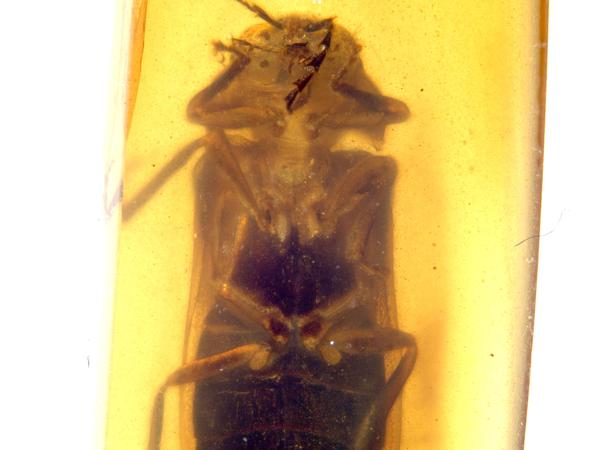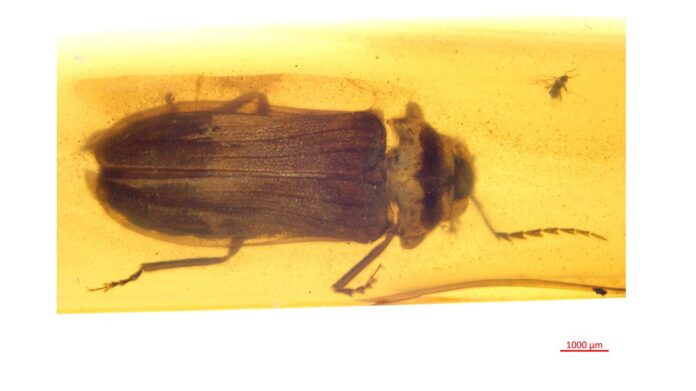Already dinosaur were probably able to see fireflies, because bioluminescence may have existed in insects as early as the Cretaceous period. A new study describes an insect trapped in amber that lived about 99 million years ago. The researchers have concluded that it is a firefly (Lampyridae). They report their results in the British Royal Society’s journal “Proceedings B”.
The newly described beetle with a light-producing organ is named Flammarionella hehaikuni. The beetle was probably a female ancestor of the modern subfamily Luciolinae, writes the research team led by Chenyang Cai from the Nanjing Institute of Geology and Palaeontology in China. “The light organ near the tip of the abdomen of Flammarionella is similar to that of today’s fireflies, which produce light.”
Lots of beetles found in an amber deposit
The discovery is the second described species of firefly from the Cretaceous period, the period from 145 to 66 million years ago. A feather firefly and a glowing beetle from the fossil family Cretophengodidae have also been discovered from this period. They were all found in 99 million year old pieces of amber found in the Hukawng Valley in northern Myanmar.
“Although these fossils come from the same amber deposit and the same time period, they show a number of morphological adaptations associated with bioluminescence,” explained the lead author. This shows that evolution during that time produced many different light-producing organs.
Bioluminescent beetles may have evolved between the Late Jurassic and Early Cretaceous period developed, the study says. “The increasing fossil finds of lampyrids are direct evidence that the breathtaking light displays of the various fireflies were already established in the Cretaceous period,” it says.
Male small fireflies fly brightly in Central Europe
Today, more than 2000 species of fireflies have been described – although only three species live in Central Europe. In some of these species, only the males can fly, not the females, and not always do both sexes produce light. If you see glowing flying specimens in this country, they are always male small fireflies (Lamprohiza splendidula).

© Chenyang Cai/Nanjing Institute of Geology and Palaeontology, Chinese Academy of Sciences/dpa
The light organs are always located on the abdomen. The green light is produced by a chemical reaction: Luciferin is converted into oxyluciferin by the enzyme luciferase. This reaction releases energy in the form of light. According to biologists, the light organs are used to find a partner or to communicate.
Study lead author Chenyang Cai explains that bioluminescence in beetles may have originally evolved as a defense mechanism. “The light emitted could have served as a warning signal to potential predators, indicating that the beetles are poisonous or inedible.” This hypothesis is supported by the fact that many beetles already have light organs as larvae, long before they are sexually mature, which indicates a function beyond courtship.
Lots of resin leads to lots of fossils
The newly discovered beetle is about 8.5 millimeters long, 2.9 millimeters wide, dark brown and densely hairy. The most striking feature is the relatively long, clearly serrated antennae – in this respect, the new species differs greatly from modern Luciolinae, the study says. These typically have thread-like, usually quite short antennae. Nevertheless, Flammarionella is now assigned to this subfamily – with the hope that other well-preserved fireflies from the Cretaceous period will soon be discovered.
Lead author Chenyang Cai explains that this hope is also justified because the trees in the Cretaceous forests produced large amounts of resin. The resin protected the trees from damage and at the same time enclosed numerous insects. “The resin quickly enclosed these organisms and protected them from decay, weathering and scavengers, which ultimately led to exceptionally well-preserved fossils.”
As the study goes on to say, the firefly has unusual changes in its antennae. The deeply engraved oval pits at the tips of the antenna segments may have served to detect odors. “This type of sensory organ in the antenna has never been documented in fireflies, but similar pits are found in many insect orders and serve as olfactory organs.” (dpa)
